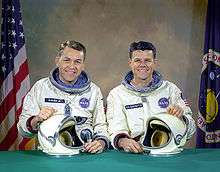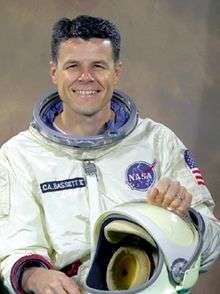Charles Bassett
| Charles A. Bassett II | |
|---|---|
 | |
| NASA Astronaut | |
| Nationality | American |
| Status | Deceased |
| Born |
December 30, 1931 Dayton, Ohio, U.S. |
| Died |
February 28, 1966 (aged 34) St. Louis, Missouri, U.S. |
Resting place | Arlington National Cemetery[1] |
Other names | Charles Arthur Bassett II |
Other occupation | Test pilot |
|
Ohio State University Texas Tech, B.S. 1960 University of Southern California | |
| Rank | Captain, USAF |
| Selection | 1963 NASA Group 3 |
| Missions | None |
Charles Arthur "Charlie" Bassett II (December 30, 1931 – February 28, 1966), (Capt, USAF), was an American electrical engineer and United States Air Force test pilot. He was selected as a NASA astronaut in 1963 and assigned to Gemini 9, but died in an airplane crash during training for his first spaceflight.
Biography
Early life and education
Bassett was born in Dayton, Ohio, on December 30, 1931.[2] He was active in the Boy Scouts of America, where he achieved its second highest rank, Life Scout. After graduating from Berea High School in Berea, Ohio in 1950, he attended Ohio State University from 1950 to 1952, and Texas Technological College, now Texas Tech University, from 1958 to 1960. He received a Bachelor of Science degree with honors in Electrical Engineering from Texas Tech; he did graduate work at University of Southern California.[2]
Military service
In 1952 he entered the United States Air Force as an Aviation Cadet. He trained at Stallings Air Force Base, North Carolina; Bryan Air Force Base, Texas; and Nellis Air Force Base, Nevada, completing advanced work in April 1954. He went to the Pacific with the 8th Fighter Bomber Group and was promoted to First Lieutenant in May 1955. He returned for pilot duties at Suffolk County Air Force Base, New York, serving until April 1958 when he took the Electrical Engineering course at the U.S. Air Force Institute of Technology at Wright-Patterson Air Force Base, Ohio.[3]
In November 1960 he went to Maxwell Air Force Base, Alabama, to attend Squadron Officer School. He graduated from the Aerospace Research Pilot School and the Air Force's Experimental Test Pilot School (Class 62A) and became a Captain in the U.S. Air Force. He then served as an experimental test pilot and engineering test pilot in the Fighter Projects Office at Edwards Air Force Base, California.
He logged over 3,600 hours-flying time, including over 2,900 hours in a jet aircraft.[2]
NASA career
| “ | "I'd always wanted to fly and wanted to fly jets, then I wanted to be a test pilot. So I was just lucky enough to follow it right along into the space program." | ” |
| — About his test pilot goals and becoming an astronaut.[4] | ||
Bassett was one of the third group of astronauts named by NASA in October 1963. In addition to participating in the overall astronaut training program, he had specific responsibilities pertaining to training and simulators. On November 8, 1965, he was selected as pilot of the Gemini 9 mission with Elliot See as Command Pilot. According to chief astronaut Deke Slayton's autobiography, he chose Bassett for Gemini 9 because he was "strong enough to carry" both himself and See. Slayton had also assigned Bassett as Command Module Pilot for the second backup Apollo crew, alongside Frank Borman and William Anders.[5]
Death

Bassett and See were killed on February 28, 1966, when their T-38 trainer jet, piloted by See, crashed into McDonnell Aircraft Building 101, known as the McDonnell Space Center, located 1,000 feet (300 m) from Lambert Field airport in St. Louis, Missouri. Building 101 was where the Gemini spacecraft was built, and they were going there to train for two weeks in a simulator. They died within 500 feet (150 m) of their spacecraft. Bassett was decapitated, and his head was found in the building's rafters.[6] Both men were buried in Arlington National Cemetery.[1][7]
A NASA investigative panel later concluded that pilot error, caused by poor visibility due to bad weather, was the principal cause of the accident. The panel concluded that See was flying too low to the ground during his second approach, probably as a result of the poor visibility.
Bassett was survived by his wife and two children.[2]
Organizations
Bassett was a member of the American Institute of Aeronautics and Astronautics, Phi Kappa Tau, Eta Kappa Nu, Tau Beta Pi and the Daedalians.[2]
Memorials
Bassett is honored at the Kennedy Space Center Visitor Center's Space Mirror Memorial, alongside 24 other NASA astronauts who died in the pursuit of space exploration.[8]
His name also appears on the Fallen Astronaut memorial plaque at Hadley Rille on the Moon.[9]

Texas Tech University dedicated an Electrical Engineering Research Laboratory building in Bassett's honor in November 1996. In attendance that day, in addition to university administrators and NASA officials, was fellow Texas Tech graduate and future NASA astronaut Rick Husband, who would himself die in the February 2003 Space Shuttle Columbia accident.
A family-approved account of Bassett's life appears in the book Fallen Astronauts by Colin Burgess and Kate Doolan UNP 2003. The crash is also mentioned in the 1998 HBO miniseries From the Earth to the Moon. His death is also dealt with in the ABC Network show "The Astronaut Wives Club" 1st aired on July 30, 2015.
See also
References
- 1 2 "Charles Arthur Bassett II". Arlington National Cemetery. Retrieved October 9, 2016.
- 1 2 3 4 5 "CHARLES A. BASSETT, II (CAPTAIN, USAF)". NASA Johnson Space Center. March 1966. Retrieved October 9, 2016.
- ↑ Charlie Bassett's military service
- ↑ Charlie Bassett's quotation Archived February 2, 2015, at the Wayback Machine.
- ↑ Slayton, Donald K. "Deke"; Cassutt, Michael (1994). Deke! U.S. Manned Space: From Mercury to the Shuttle (1st ed.). New York: Forge (St. Martin's Press). p. 167. ISBN 0-312-85503-6. LCCN 94-2463. OCLC 29845663.
- ↑ McMichael, W. Pate (May 2006). "Losing The Moon". St. Louis Magazine. St. Louis, MO. Retrieved June 10, 2012.
- ↑ "Elliott M. See, Jr., Commander, United States Navy Reserve". Arlington National Cemetery. Retrieved June 25, 2016.
- ↑ "The Astronauts Memorial Foundation Space Mirror Memorial". The Astronauts Memorial Foundation. Retrieved October 9, 2016.
- ↑ Eveleth, Rose (January 7, 2013). "There Is a Sculpture on the Moon Commemorating Fallen Astronauts". Smithsonian. Retrieved October 9, 2016.
Bibliography
- Codex Regius (2014). The Forgotten Astronauts:A rarely told Chapter of American Spaceflight History. ISBN 1-4996-1012-2.
External links
| Wikimedia Commons has media related to Charles Bassett. |
- Astronauts memorial foundation website
- Bassett at Spaceacts
- Astronautix biography of Charles Bassett
- Charles Bassett at the Internet Movie Database
- Charles Bassett at Astronauts Memorial page
